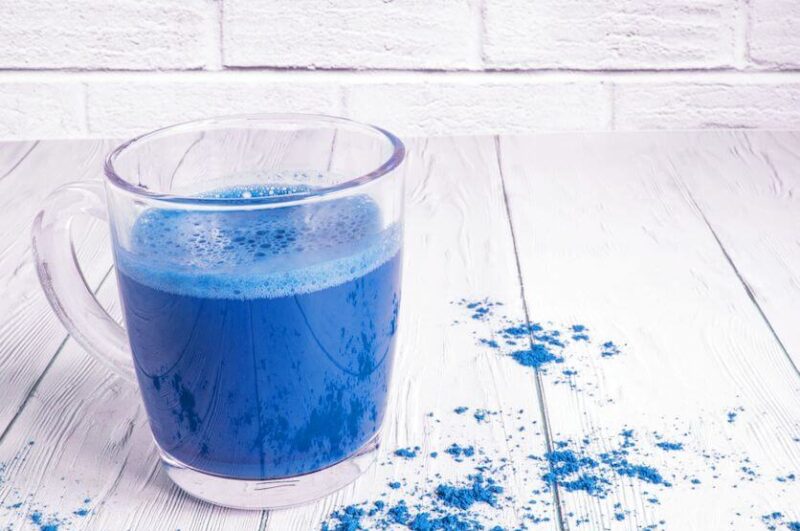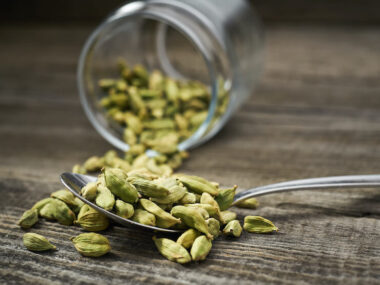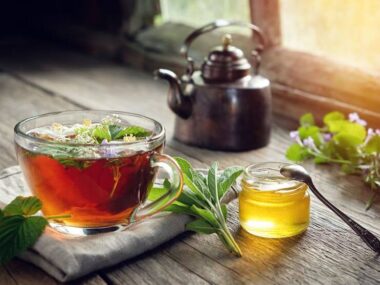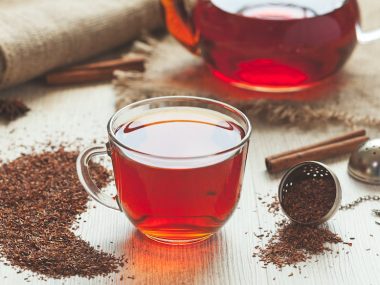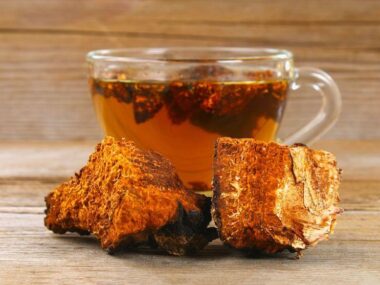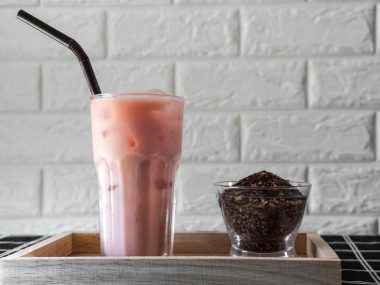If the essence of a mermaid could be caught in a glass of tea, the blue matcha tea is the one! But beware, a glass of this “mermaid water” may not be what you think. “Matcha” doesn’t “match up” with this tea!
Table of Contents
What Is Blue Matcha Tea?
Blue matcha tea is not a true tea but rather a tisane (herbal tea.) It is made from ground powder (blue matcha powder) that comes from the Butterfly Pea Flower plant. The most common way this tea is enjoyed is in latte form with frothed milk.
Blue matcha is often mistaken as blue-tinted green matcha tea. However, these teas are two completely different drinks.
- Green matcha is a true tea that is made from ground-up leaves from the tea plant (Camellia sinensis.)
- Blue matcha is a ground-up powder made from the Butterfly Pea Flower plant (Clitoria ternatea.)
Admittedly, both blue and green matcha teas are vibrant in color and presentation, but one tea is highly beneficial whereas the other, well, not so much.
Butterfly Pea Flower as the Main Ingredient for Blue Matcha
Butterfly Pea Flower has been around for a very long time. It has naturalized in many countries around the world that includes Hawaii, Australia, the West Indies, Jamaica, the Bahamas, Cuba, Africa, Asia, and parts of the U.S. (California, Texas, Georgia, Florida.)
This plant is a vine with vibrant blue blooms that look similar to part of the female genitalia (hence the name “Clitoria.”). The flowers on the plant are not only used to make blue matcha powder but also to dye fabrics as a coloring for foods and even cosmetics.
Teas made from the flower of the Butterfly Pea Flower plant are often called “blue tea,” “blue matcha,” or “Butterfly Pea Flower tea.”
Coloring-Changing Ability
An amazing thing about tea made from Butterfly Pea Flower is it can change color by introducing lemon or hibiscus leaves. Some refer to this tea as a “mood ring in a glass.” Blue matcha tea will do the same thing provided the tea does not contain milk. A latte version of blue matcha won’t change color because the milk changes the acidity. Just a word of caution, if you add lemon juice to milk, it will have a curdling effect.
However, blue matcha tea can be made with just water, and by adding a few drops of lemon, you will see your tea go from blue to purples, reds, and pinks. It’s quite beautiful! The flowers of the Butterfly Pea Flower plant contain natural pigments of blues and reds called anthocyanins. When these pigments are exposed to acid (drops of lemon juice,) they begin to change color.
Other Uses Of The Butterfly Pea Flower Plant
A staple dish in Malaysia uses an infusion of flowers from this plant while boiling rice to create gelatin-like rice that is blue. In Thailand, you can find another delicious local staple — Nam Dok Anchan. It’s a coconut milk and blue matcha powder beverage. Laotians make blue chocolates from the blue matcha. Burmese dip the blue flowers in a batter and fry until they are golden and crispy to serve with meals.
What Is Blue Matcha Made Of?
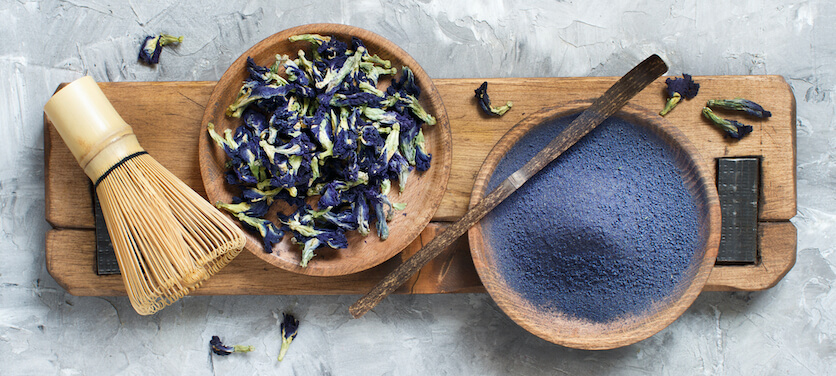
The foundation of blue match tea is, of course, the blue matcha powder. This powder is ground-up flowers from the Butterfly Pea Flower plant. It has ultra-fine with the texture of talcum powder or cornstarch.
Blue matcha tea is traditionally made with very little water and a lot of frothy milk. Add the powder to the water with the milk following thereafter. This tea can also be prepared with just water and blue matcha powder. When this method is used, the tea is a vibrant blue and often referred to as “blue tea.”
What Does Blue Matcha Taste Like?
Blue matcha may fool you into thinking your palate will be met with a fruity, floral taste. It’s the color that tricks you into assuming this. Instead, you will taste a more earthy, grassy, vegetal flavor with slight notes of floral.
When adding the milk to create the latte version of blue matcha, those flavors are carried even further. Depending on what form of dairy you add, you will have a smooth, nutty, sweet finish that rolls right through.
Does Blue Matcha Have Caffeine?
Blue matcha is void of caffeine because it is not made from the tea plant. Although blue matcha tea is labeled as a “tea,” it is not a true tea but a tisane which is herbal. Herbal teas do not contain caffeine.
Is it Okay to Drink Blue Matcha Tea Every Day?
Scientific data on how Clitoria ternatea (Butterfly Pea Flower plant) affects animals concludes that high doses of root extracts of the plant are toxic. When the extracts were given to mice in a study, it caused profuse diarrhea and depressed the overall central nervous system.
As to how ingesting any part of the plant affects humans, more investigations are warranted.
Claims of health benefits for humans lack validity, as explained in another study conducted by researchers. We lack the expertise to recommend or not recommend drinking blue matcha tea daily, which leaves the decision to drink or not to drink it daily up to you.
Blue Matcha Benefits

There is no scientific evidence concerning how blue matcha tea benefits humans since the studies were conducted with animals. However, Ayurvedic and Eastern medicine use parts of the Butterfly Pea Flower plant to treat numerous ailments.
Mood Booster
The intentional time set aside to have a cup of tea is relaxing. You can slow down and pause life for a few moments while you enjoy your brew. Such a ritual helps us recharge to continue with our day. A cup of blue matcha tea may perhaps evoke a sense of calm and peace that’s reminiscent of the soothing ocean air and the sound of waves breaking.
Helps Skin Conditions
Butterfly Pea Flower was found by researchers to be beneficial when used topically for irritation such as itching or redness. Additionally, the plant’s antioxidants encouraged moisture retainment in the skin. By incorporating the plant into beauty products, the anthocyanins in the plant compounds helped reduce the look of aging skin.
How to Drink Blue Matcha Tea
We have a few creative recipes for you to enjoy blue matcha tea. The fun blue color added to a glass, whether served hot or cold, in the summer or winter, is like serving up a piece of artwork!
Traditional Blue Matcha Latte
Ingredients
- ½ cup of milk
- ½ cup of water
- 1 teaspoon of blue matcha powder
- 1 teaspoon of honey
Directions
- Boil the water.
- Remove from heat.
- Add 1 teaspoon of blue matcha powder and 1 teaspoon of honey to hot water and mix well.
- Pour blue matcha tea into a cup.
- Froth ½ cup of milk.
Tip: If you don’t have a frother, you can warm your milk while whisking heavily.
- Pour the frothed milk on top of the tea.
- Lightly sprinkle a bit of blue matcha powder on top of the milk.
- Enjoy!
Mermaid Matcha Over Ice
With this fun recipe, it’s all about layering.
Ingredients
- Ice cubes
- 1 tablespoon of honey
- 1 ½ cup of vanilla soy milk
- 1 teaspoon of blue matcha powder (Butterfly Pea Flower powder)
- 1 teaspoon of green matcha tea powder
Directions
- Fill a glass with ice cubes.
- Pour honey and ½ cup of soy milk in a bowl.
- Whisk until thoroughly mixed.
- Pour over the ice in your glass.
Tip: As tempting as it may be to stir, don’t stir the drink at all, or it will ruin the “mermaid” effect.
- Rinse the bowl out and dry.
- Pour ½ cup of soy milk into the bowl and add 1 teaspoon of blue matcha powder.
- Whisk until thoroughly mixed.
- Pour slowly into the glass over the first milk layer.
- Rinse the bowl out and dry.
- Pour ½ cup of soy milk into the bowl and add 1 teaspoon of green matcha powder.
- Whisk until thoroughly mixed.
- Slowly pour over the blue matcha milk layer.
- Add a straw and enjoy!
Tip: For added effect, add a small dollop of whipped cream on top and finish with a few blueberries.
Blue Matcha “Mood Ring In A Cup”
Ingredients
- 6 cups of water
- 4 teaspoons of blue matcha powder
- 1 lemon (quartered slices to squeeze into individual glasses)
- 3 teaspoons of honey
- Ice
Directions
- Bring 6 cups of water to a boil.
- Remove from heat.
- Add 4 teaspoons of blue matcha powder to water and stir until dissolved.
- Set tea aside to cool
- Pour cooled tea into a tea pitcher or individual glasses filled with ice.
- Just before drinking, squeeze a few drops of lemon juice into the tea to watch it change colors.
- Enjoy!
Boost Your “Blue”!
Although blue matcha tea is a gorgeous herbal tea to enjoy, keep in mind the “unknowns” of enjoying it, especially if you choose to partake often. Elevate that cup of “blue” by adding green matcha. This takes the tea up to a super-healthy, uber-beneficial tea that we can highly recommend!
